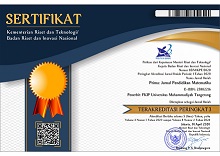AN ANALYSIS OF A GEOMETRY LEARNING PROCESS: THE CASE OF PROVING AREA FORMULAS
Abstract
Geometry is one of the courses in the curriculum for students of prospective mathematics teachers that can develop deductive thinking ability. The question is, how is the learning and teaching process of the geometry course implemented so as to develop this deductive thinking ability? This research, therefore, aims to investigate the learning and teaching process of a geometry course for prospective mathematics teachers. For reaching these aims, this qualitative study was conducted through observations on the learning process and the written test of a geometry course, for the case of area formulas, involving 56 students of mathematics education program. The results revealed that the learning process is implemented by emphasizing the use of the deductive approach, and from the written test we found various proof strategies in proving an area formula. We conclude that the learning and teaching process of the geometry course has influenced the development of student deductive thinking.
Keywords
Full Text:
PDFReferences
As’ari, A. R. (2005). Pembelajaran geometri untuk menantang berpikir tingkat tinggi. In proceedings of Konferensi Nasional Pendidikan Matematika: Peningkatan Kualitas Matematika di Sekolah, SBI Madania & Himpunan Matematika Indonesia.
Breyfogle, M. L., & Lynch, C. M. (2010). Van Hiele revisited. Mathematics Teaching in The Middle School, 16(4), 233–238.
Burger, W. F., & Shaughnessy, J. M. (1986). Characterizing the van Hiele levels of development in geometry. Journal for Research in Mathematics Education, 17(1), 31–48.
Clements, D. H. (1985). Perspective on “the child’s thought and geometry”. Classic in Mathematics Education Research, pp. 60, State University of New York at Buffalo.
Crowley, M. L. (1987). The Van Hiele model of the development of geometric thought. In Learning and Teaching Geometry, K-12, 1987 Yearbook of the National Council of Teachers of Mathematics, edited by M. M. Lindquist, pp. 1–16, Reston Va: National Council of Teachers of Mathematics.
Hanna, G. (2000). Proof, explanation and exploration: An overview. Educational Studies in Mathematics, 44(1), 5-23.
Hershkowitz, R. (1998). About reasoning in geometry. In C. Mammana (Ed.), Perspective on the teaching of geometry for the 21st century (pp. 29-36). Dordrecht/Boston/London: Kluwer Academic Publishers.
Howse, T. D., & Howse, M. E. (2015). Linking the Van Hiele theory to instruction. Teaching Children Mathematics, 21 (5), 305–313.
Jupri, A., & Syaodih, E. (2016). Between formal and informal thinking: The use of algebra for solving geometry problems from the perspective of Van Hiele theory. Jurnal Pengajaran Matematika dan Ilmu Pengetahuan Alam, 21(2), 1-7.
Jupri, A. (2017). From geometry to algebra and vice versa: Realistic mathematics education principles for analyzing geometry tasks. In AIP Conference Proceedings (Vol. 1830, No. 1, pp. 050001-1-05001-5). AIP Publishing.
Jupri, A., & Herman, T. (2017). Theory and practice of mathematics teacher education: An explorative study at the department of mathematics education, Indonesia University of Education. In Proceedings of International Conference on Mathematics and Science Education. Atlantis Press.
Jupri, A. (2018). Using the Van Hiele theory to analyze primary school teachers’ written work on geometrical proof problems. Journal of Physics: Conference Series, 1013 (1). 1-5.
Mayadiana, D. (2011). Mengembangkan kemampuan penalaran dan pemecahan masalah kreatif matematis mahasiswa calon guru SD melalui pembelajaran dengan pendekatan induktif. Disertasi (Tidak Dipublikasikan). Bandung: Prodi Pendidikan Matematika SPs, Universitas Pendidikan Indonesia.
Moise, E. E. (1990). Elementary geometry from an advanced standpoint. Reading, Massachusetts: Addison-Wesley Publishing Company.
Prince, M.J., & Felder, R.M. (2006). Inductive teaching and learning methods: Definitions, comparisons, and research bases. Journal of Engineering Education, 95(2), 123-138.
Ruseffendi, E. T. (1991). Pengantar kepada membantu guru mengembangkan kompetensinya dalam pengajaran matematika untuk meningkatkan CBSA. Bandung: Tarsito.
Soedjadi, R. (2000). Kiat pendidikan matematika di Indonesia. Konstatasi keadaan masa kini menuju harapan masa depan. Jakarta: Dirjen DIKTI Departemen Pendidikan Nasional.
Szetela, W., & Nicol, C. (1992). Evaluating problem solving in mathematics. Educational Leadership, 42–45.
Teppo, A. (1991). Van Hiele levels of geometric thought revisited. The Mathematics Teacher, 84(3), 210–221.
Van Hiele, P. M. (1999). Developing geometric thinking through activities that begin with play. Teaching Children Mathematics, 6, 310–316.
Wallace, E.C., & West, S. F. (1998). Roads to geometry. Upper Saddle River, NJ: Prentice Hall.
DOI: http://dx.doi.org/10.31000/prima.v4i2.2619
Article Metrics
Abstract - 992 PDF - 698Refbacks
- There are currently no refbacks.
Prima: Jurnal Pendidikan Matematika
Program Studi Pendidikan Matematika
Fakultas Keguruan dan Ilmu Pendidikan
Universitas Muhammadiyah Tangerang
Jl. Perintis Kemerdekaan I/33, Cikokol
Kota Tangerang, Indonesia
e-mail: primajpm@gmail.com
Prima: Jurnal Pendidikan Matematika (p-ISSN: 2579-9827 | e-ISSN: 2580-2216) is licensed under a Creative Commons Attribution 4.0 International License.







